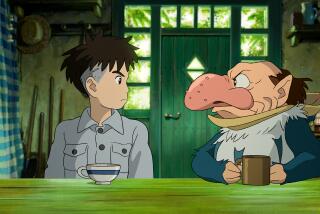Review: ‘Stormdancer’ by Jay Kristoff thrills in a dystopian Japan
- Share via
Stormdancer
The Lotus War Book One
Jay Kristoff
St. Martin’s/Thomas Dunne: 336 pp., $24.99
With its geisha girls in gas masks and canvas blimps spewing black exhaust as they chug across the sky, “Stormdancer” paints a vivid picture of a decrepit, steampunk Japan. It’s startling to witness a country that so reveres nature presented in such an environmentally compromised position, as it is in the kickoff to Jay Kristoff’s “The Lotus War” series. But it’s this inventive juxtaposition that makes “Stormdancer” such a thrilling addition to the increasingly tired yet continuously expanding dystopian scene.
“Stormdancer” is not a young-adult title, though its heroine is a teenager and the book features many of the genre hallmarks made famous by Suzanne Collins’ “The Hunger Games”: A polluted, overcrowded landscape prompts a sharp social divide that sows the seeds of rebellion and, of course, a love triangle involving a brave young woman who doesn’t understand her attractiveness.
What’s unique here is the setting, which calls upon foreign mythologies and an Imperial Asian caste system that Kristoff marries with an interspecies, paranormal twist.
In “Stormdancer,” the Lotus flower isn’t portrayed as an object of innocent beauty. It represents the root of society’s ills. It’s a plant that is cultivated as a psychotropic tobacco, and as an ozone-depleting fuel, in fields that are worked by fair-skinned, round-eyed gaijin slaves. Everything that takes place on the island nation is in service to the toxic blood lotus, the burning of which forces everyone to wear goggles to shield their eyes from the sun’s strengthening intensity and breathing devices to stave off black lung.
“Stormdancer” revolves around the aspirations of 20-year-old Shogun Yoritomo, who has ordered the drug-addled father of 16-year-old Yukiko to hunt a thunder tiger — a winged beast that, at worst, is merely mythological and, at best, is long extinct. Yukiko sees the Shogun’s order for what it is: a fool’s errand at the behest of an arrogant, entitled ruler. Yet she, along with her family and various government minders, are launched into the sky to find one and bring it back.
Finding one turns out to be the easy part. The tiger, or arashitora, has a wingspan of 25 feet and talons as sharp as a Ginsu. Tranquilizers that could easily sedate a rhinoceros are ineffective, but Yukiko has a gift. She can “mind speak” with animals — a talent she’s able to hone when the airborne blimp in which the tiger is caged bursts into flames, and Yukiko opts to save the flying beast.
Thus begins the first of many uneasy alliances in a complex plot to overthrow the Shogun, whose rule has led to streets packed with “grubby children with growling bellies and shanks of sharpened iron hidden in their rags.” It’s a violent world filled with exotic Japanese weapons that could “lay entire armies of meat to waste” and so many other Japan-isms that Kristoff has wisely included a glossary at the back of the book. While many of the terms pertain to Kristoff’s complex world-building and are fairly easy to understand through contextual clues, the definitions are an excellent resource for more detailed information about the many factors that service Kristoff’s intricate and well-executed plot.
In her travels with the tiger, Yukiko comes into contact with a broad spectrum of characters, from scrappy rebel fighters to privileged royalty, all of whom shape her worldview and cause her to question the wisdom of blind loyalty. She uncovers secrets about her family that reframe long-held assumptions about her father’s drug use.
And she begins to understand and wield her power, both physically and sexually. It’s the inclusion of a brief, innocuous sex scene and some coarse language that likely classifies “Stormdancer” as an adult, rather than a young-adult, title. But the sexual content and language isn’t at all graphic — or anything a modern teen hasn’t already experienced in the broader culture. At its core, “Stormdancer” may be an environmental and socioeconomic morality play, but it reads like a fast-paced, fantastical adventure and is sharp as a Shogun’s sword.
More to Read
The biggest entertainment stories
Get our big stories about Hollywood, film, television, music, arts, culture and more right in your inbox as soon as they publish.
You may occasionally receive promotional content from the Los Angeles Times.










